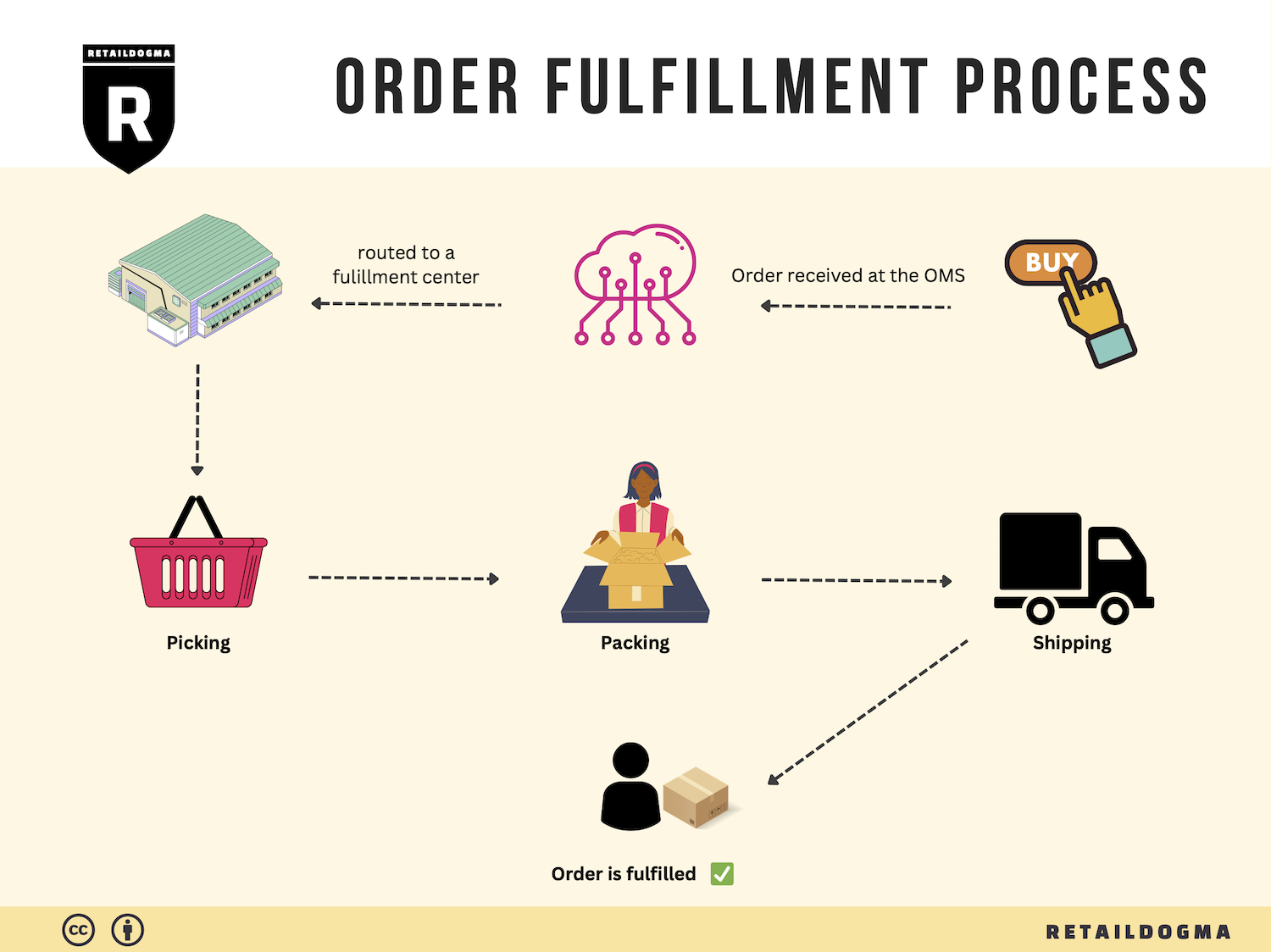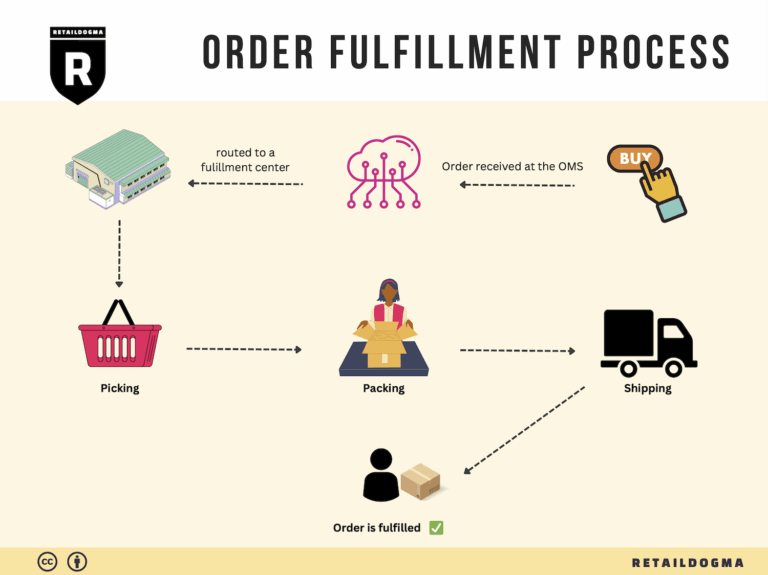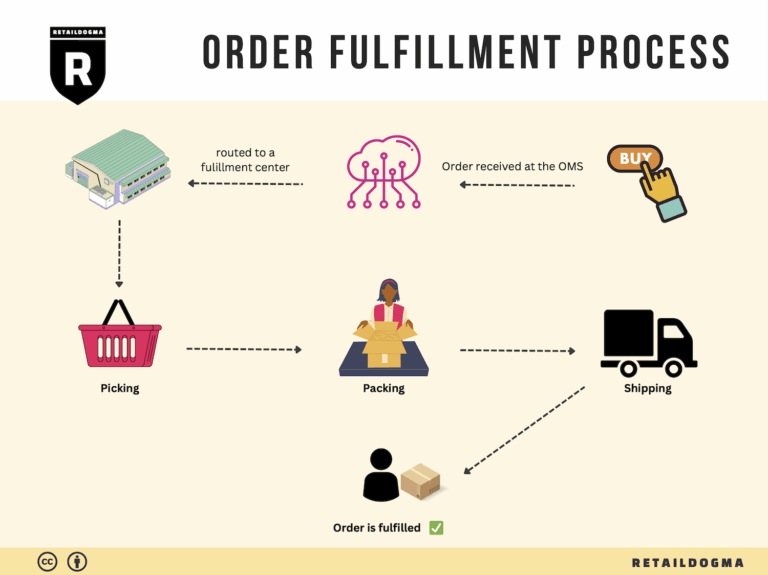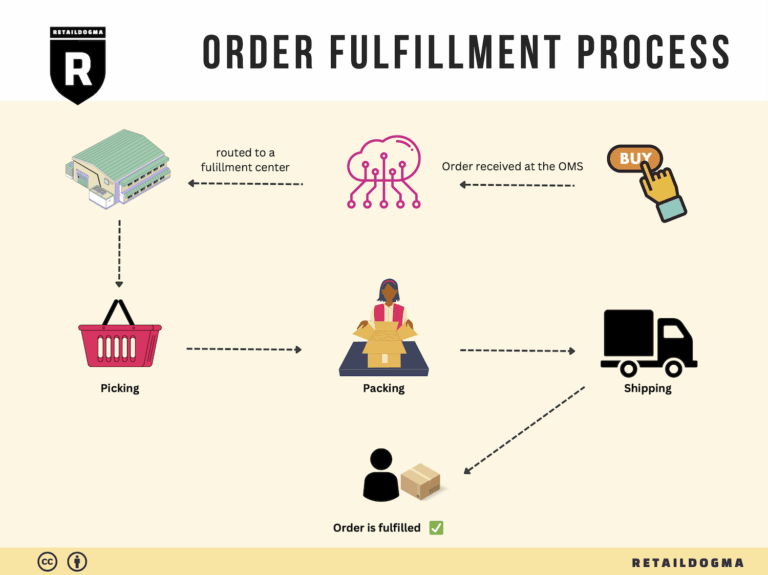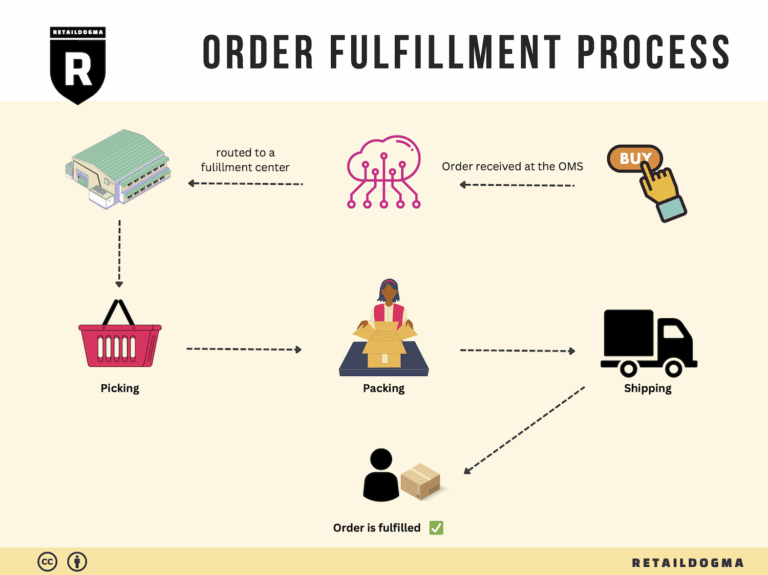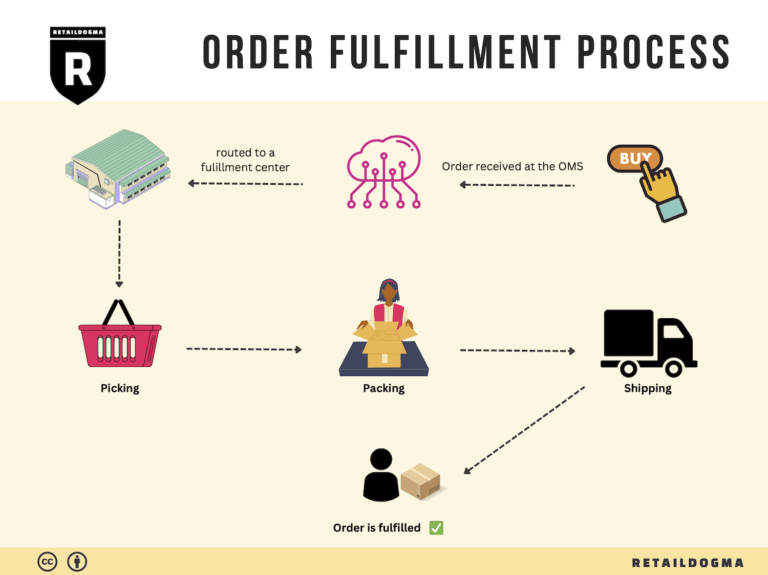What Is A Fulfillment Center? A Complete Guide (2025)
What is E-commerce Fulfillment? An Introduction for Growing Businesses
As an e-commerce business owner, the thrill of growing sales can quickly turn into stress when you find yourself overwhelmed with the logistics of packing and shipping orders. Managing order fulfillment can become a daunting task, often detracting from your ability to focus on scaling your business. Fulfillment, simply put, is the process of getting a product from your inventory to your customer’s doorstep, and it encompasses everything from storage and inventory management to packing, shipping, and handling returns.
In this guide, we will explore the various models of e-commerce fulfillment that can help alleviate these burdens and streamline your operations. You’ll learn about Third-Party Logistics (3PL) providers, Fulfilled by Amazon (FBA), and Walmart Fulfillment Services (WFS), each offering unique advantages tailored to different business needs. Understanding these models will empower you to make informed decisions based on your specific requirements.
We will delve into the core services associated with e-commerce fulfillment, including storage solutions, order processing, shipping logistics, and customer service. These services are essential for maintaining a seamless experience for your customers while freeing up your time to focus on strategic growth initiatives.
Choosing the right fulfillment partner is crucial to your business’s success. We’ll provide guidance on key factors to consider, such as scalability, cost-effectiveness, and the quality of customer service. By weighing these aspects, you can identify a partner that aligns with your business goals and operational needs.
Pricing can often be a source of confusion for growing businesses. In this guide, we will break down the typical costs associated with various fulfillment models, helping you understand how to budget for these services effectively.
Ultimately, the goal of this guide is to empower you to make smart, strategic decisions about your logistics and fulfillment processes. By equipping you with the knowledge and tools necessary to navigate the complexities of e-commerce fulfillment, we aim to help you streamline your operations, enhance customer satisfaction, and position your business for sustained growth in an increasingly competitive marketplace.
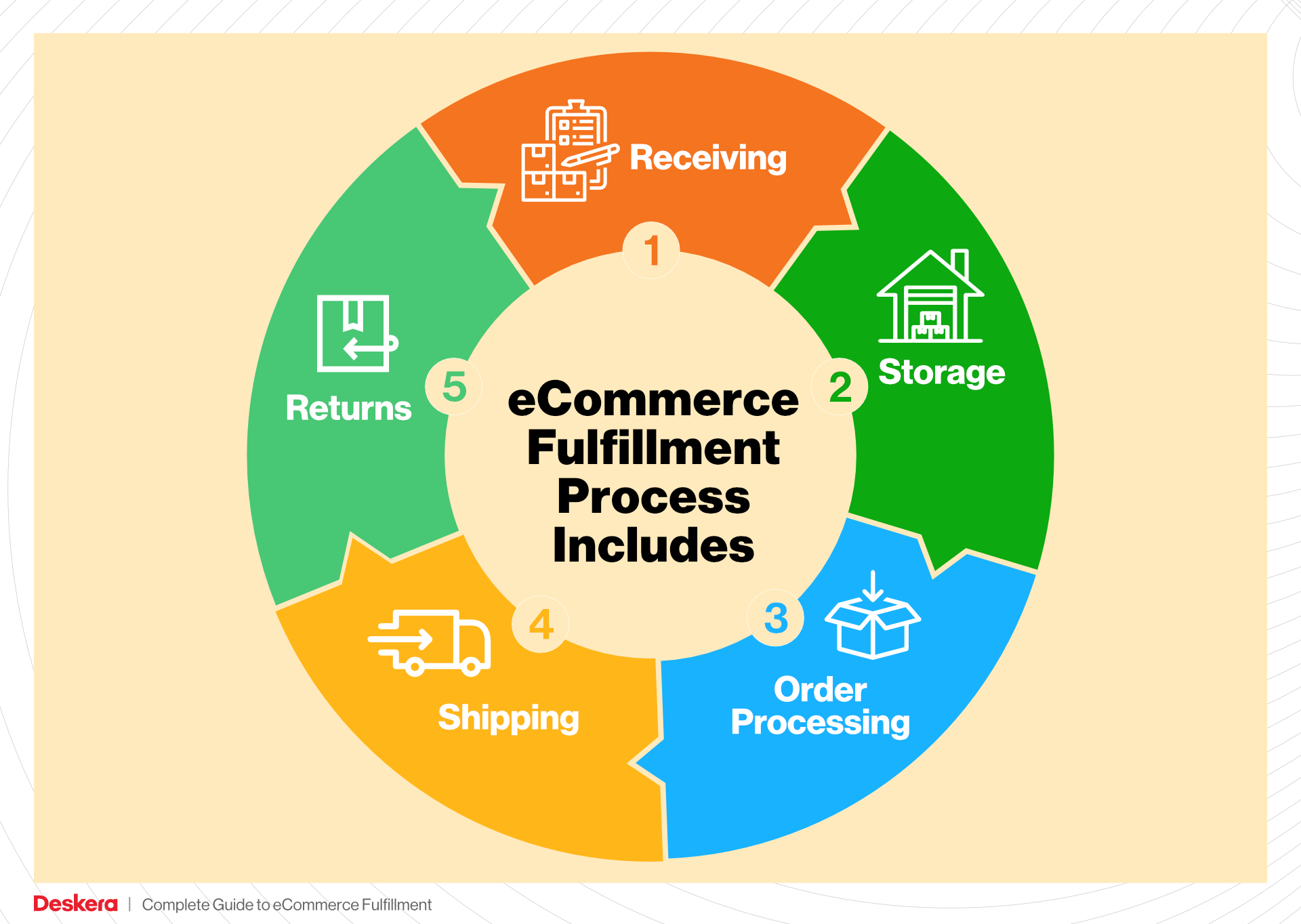
What You’ll Learn In This Guide
- What is E-commerce Fulfillment? An Introduction for Growing Businesses
- The Order Fulfillment Process: From ‘Buy’ Button to Customer’s Door
- Comparing Fulfillment Models: In-House vs. 3PL vs. Dropshipping
- A Deep Dive into Amazon FBA: Pros, Cons, and Who It’s For
- Core Services Offered by Fulfillment Centers
- How to Choose a Fulfillment Partner: A 6-Point Checklist
- Understanding Fulfillment Pricing: A Breakdown of Common Fees
- Frequently Asked Questions (FAQs) about Fulfillment
- Conclusion: Is Outsourcing Fulfillment the Right Move for Your Business?
- Important Disclaimer
The Order Fulfillment Process: From ‘Buy’ Button to Customer’s Door
1. Receiving Inventory
The order fulfillment process begins with receiving inventory at the Walmart Fulfillment Center (WFC). When sellers ship their products to WFC, they must ensure that the items are labeled and packed according to Walmart’s guidelines. This step is crucial as it establishes the foundation for accurate inventory management. Each product is assigned a Stock Keeping Unit (SKU), which is a unique identifier that allows for easy tracking and management of inventory levels.
Upon arrival, the inventory is inspected for quality and accuracy against the shipping manifest. Any discrepancies can lead to delays in fulfillment and potential financial losses. Efficient receiving processes help maintain optimal stock levels, reduce errors, and improve overall supply chain performance. Ensuring that inventory is accurately received and recorded sets the stage for the following steps in the fulfillment process.
2. Warehouse Storage
After inventory is received and accounted for, it is stored in designated areas within the fulfillment center. This step involves strategic warehouse management practices to maximize space utilization and facilitate easy access to products. Proper storage methods are essential for maintaining product integrity and ensuring that items are easy to locate when orders are placed.
Walmart employs advanced warehouse management systems (WMS) that utilize barcoding and RFID technology to streamline this process. These systems help in organizing products in a way that optimizes picking efficiency and minimizes search times. Key terms such as “bin locations” are used to denote specific storage spots within the warehouse. Effective warehouse storage strategies contribute to reduced lead times and faster order fulfillment, ultimately enhancing customer satisfaction.
3. Order Picking
Once a customer places an order on Walmart.com, the next step is order picking. This process involves retrieving the correct items from their storage locations to fulfill the order. A pick list, which outlines the items needed for each order, is generated to guide warehouse staff in efficiently gathering products.
Order picking is a critical step in the fulfillment process because any errors at this stage can lead to incorrect shipments, resulting in customer dissatisfaction and increased return rates. Walmart employs various picking methods, including single order picking, batch picking, and zone picking, to optimize efficiency based on the volume and type of orders. Ensuring accuracy in order picking is vital for maintaining high service levels and building trust with customers.
4. Order Packing
After the items are picked, they move on to the packing stage. Here, products are carefully packed into boxes for shipment. The packing process is not merely about placing items in a box; it involves selecting appropriate packaging materials to protect the items during transit, labeling packages accurately, and including any necessary documentation.

This step is important as it ensures that the products arrive at the customer’s door in perfect condition. Proper packing techniques reduce the risk of damage during shipping, which can result in costly returns and replacements. Key terms associated with this stage include “packing slips” and “dimensional weight,” which influence shipping costs. Efficient packing processes contribute to faster turnaround times and enhance the overall customer experience.
5. Shipping & Delivery
The final step in the order fulfillment process is shipping and delivery. Once orders are packed, they are handed over to logistics partners for transportation to the customer’s address. Walmart Fulfillment Services leverages its extensive logistics network to provide fast and reliable delivery options, including 2-day shipping for eligible items.
Shipping and delivery are crucial for maintaining customer satisfaction and loyalty. Timely delivery is often a key factor in the purchasing decision, and delays can lead to negative customer experiences. Key terms such as “last-mile delivery” and “tracking numbers” are significant in this stage, as they provide customers with visibility into their order status and estimated delivery times. A well-managed shipping process not only fulfills customer expectations but also strengthens the seller’s brand reputation and encourages repeat business.
In summary, each step of the order fulfillment process plays a vital role in ensuring that products move seamlessly from the seller to the customer. Understanding and optimizing these steps can lead to improved operational efficiency, increased sales, and enhanced customer satisfaction.
Comparing Fulfillment Models: In-House vs. 3PL vs. Dropshipping
Fulfillment Models Comparison
| Model | Who Handles Inventory | Best For (Business Stage) | Key Advantage | Key Disadvantage |
|---|---|---|---|---|
| In-House Fulfillment | Your company | Established businesses with stable demand | Full control over inventory and order processing | High operational costs and resource requirements |
| Third-Party Logistics (3PL) | Third-party provider | Growing businesses and startups | Cost-effective scalability and expertise in logistics | Less control over inventory and fulfillment processes |
| Dropshipping | Supplier or manufacturer | Startups and entrepreneurs | Low startup costs and no inventory holding | Lower profit margins and potential quality control issues |
In-House Fulfillment
In-house fulfillment refers to a model where a company manages all aspects of storage, inventory, order processing, and shipping internally. This model is typically best suited for established businesses that have stable demand and sufficient resources to manage logistics effectively. One of the primary advantages of in-house fulfillment is the level of control it provides over inventory management and order processing. Companies can implement their own procedures, maintain quality control, and directly manage customer service interactions. However, this model also comes with significant disadvantages, including high operational costs associated with warehousing, staffing, and technology investments. As businesses scale, these costs can increase, potentially impacting profitability. Additionally, in-house fulfillment requires a considerable time commitment, which can detract from focusing on core business functions such as marketing and product development.
Third-Party Logistics (3PL)
Third-party logistics (3PL) involves outsourcing logistics operations to specialized providers who manage warehousing, inventory, and shipping on behalf of a business. This model is ideal for growing businesses and startups that may not have the resources or expertise to handle logistics internally. One of the key advantages of 3PL is cost-effective scalability; businesses can expand their operations without the need to invest heavily in infrastructure or staff. Providers often have established relationships with carriers, which can lead to lower shipping rates and improved delivery times. Additionally, 3PL companies offer expertise in logistics management, which can enhance operational efficiency. However, the primary disadvantage is that businesses relinquish a degree of control over their inventory and fulfillment processes. This can lead to challenges in maintaining brand consistency and quality, as well as potential communication issues between the business and the 3PL provider.
Dropshipping
Dropshipping is a fulfillment model where the retailer does not keep products in stock but instead transfers customer orders directly to a supplier or manufacturer, who then ships the products directly to the customer. This model is particularly appealing for startups and entrepreneurs looking to minimize upfront costs and inventory risks. The primary advantage of dropshipping is the low barrier to entry; businesses can launch quickly without the need to invest in inventory or warehousing. This model allows for a wide range of products to be offered without significant financial commitment. However, dropshipping also comes with notable disadvantages, including lower profit margins due to reliance on suppliers for pricing and fulfillment. Additionally, businesses may face challenges with quality control, as they have limited oversight of the products being shipped. Shipping times can also be longer, impacting customer satisfaction. Overall, while dropshipping offers flexibility and reduced financial risk, it requires careful management of supplier relationships and customer expectations.
Conclusion
When choosing a fulfillment model, e-commerce business owners should consider their current stage of growth, available resources, and long-term goals. Each model—whether in-house fulfillment, 3PL, or dropshipping—has its unique advantages and disadvantages that can significantly impact operational efficiency, customer satisfaction, and profitability. Understanding these dynamics will enable entrepreneurs to make informed decisions that align with their business strategies and customer expectations.
A Deep Dive into Amazon FBA: Pros, Cons, and Who It’s For
Understanding Fulfillment by Amazon (FBA)
Fulfillment by Amazon (FBA) is a service provided by Amazon that allows sellers to store their products in Amazon’s fulfillment centers. Amazon takes care of storage, packaging, and shipping of the products directly to the customers. Additionally, FBA also handles customer service and returns, making it an attractive option for many e-commerce businesses looking to streamline their operations and expand their reach.
How FBA Works
-
Set Up Your Account: Sellers need to create an Amazon seller account and enroll in the FBA program.
-
Prepare Your Products: Products must be prepared according to Amazon’s guidelines, which include labeling, packaging, and shipping requirements.
-
Ship Inventory to Amazon: Once products are ready, sellers ship their inventory to Amazon’s fulfillment centers. Amazon provides shipping plans to help sellers determine where to send their items.
-
Storage and Management: Amazon stores the products in its warehouses. Sellers can monitor their inventory levels through the Amazon Seller Central dashboard.
-
Order Fulfillment: When a customer places an order, Amazon picks, packs, and ships the product on behalf of the seller. The seller does not need to handle the logistics of shipping.
-
Customer Service: Amazon manages customer inquiries and returns, allowing sellers to focus on other aspects of their business.
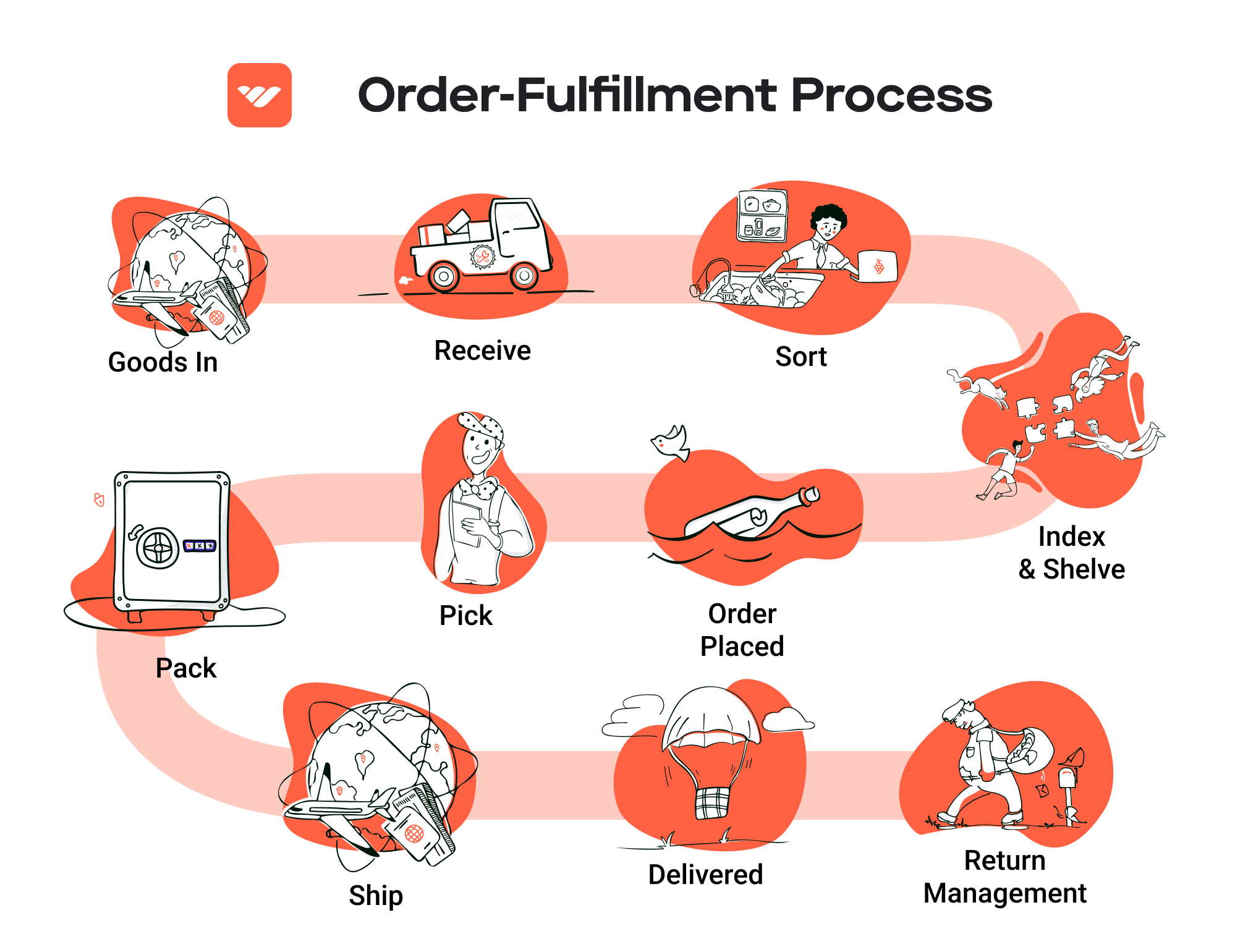
-
Payment: After the sale, Amazon deducts its fees and transfers the remaining balance to the seller’s account.
Pros of FBA
-
Prime Eligibility: One of the most significant advantages of using FBA is the access to Amazon Prime customers. Products fulfilled by Amazon are eligible for Prime shipping, which can significantly increase sales, as Prime members tend to prefer items with faster shipping options.
-
Customer Trust: Listing products through FBA can enhance customer trust. Amazon is known for its reliable service, and customers are more likely to purchase products that are backed by Amazon’s fulfillment services.
-
Multi-Channel Fulfillment: FBA is not limited to just Amazon sales. Sellers can use Amazon’s fulfillment services to ship products sold on other platforms, such as their own e-commerce websites or eBay, allowing for a centralized inventory management system.
-
Scalability: FBA enables sellers to scale their businesses without the burden of managing logistics. As demand grows, sellers can simply send more inventory to Amazon without needing to invest in their own warehousing or shipping capabilities.
-
Time Savings: By outsourcing fulfillment to Amazon, sellers can save time on storage, packing, and shipping, allowing them to focus on marketing, product development, and customer engagement.
Cons of FBA
-
High Fees: One of the main drawbacks of FBA is the cost. Amazon charges various fees, including storage fees and fulfillment fees, which can add up quickly, especially for slow-moving items. Sellers must carefully calculate these costs to ensure profitability.
-
Strict Inventory Rules: Amazon has strict guidelines regarding inventory management. Sellers must adhere to these rules, which can include limitations on the number of units stored and requirements for inventory health. Failure to comply can lead to penalties or account suspension.
-
Commingling Risks: FBA uses a commingling model, meaning that sellers’ inventory may be mixed with other sellers’ products in the fulfillment centers. This can pose risks, such as the potential for counterfeit products or damaged items being shipped to customers, which can harm a seller’s reputation.
-
Limited Control Over Shipping: Once the inventory is in Amazon’s hands, sellers have limited control over the shipping process. This can lead to issues if there are delays or errors in fulfillment, impacting customer satisfaction.
-
Return Management: While Amazon handles customer service and returns, sellers may find it challenging to manage returns effectively. Returned items may not always be restocked in sellable condition, leading to potential losses.
Who is FBA Best For?
Fulfillment by Amazon is particularly beneficial for:
-
Small to Medium-Sized Businesses: Companies that lack the resources to manage their own fulfillment operations can greatly benefit from FBA, leveraging Amazon’s extensive logistics network.
-
E-commerce Entrepreneurs: New sellers looking to quickly establish a presence on Amazon can take advantage of FBA’s trusted infrastructure and customer base.
-
Product Categories with High Demand: Sellers offering products that have a proven track record of high sales volume and fast turnover can capitalize on the advantages of FBA, especially those looking to reach Prime customers.
-
Multi-Channel Sellers: Businesses that sell across various platforms and want to streamline their fulfillment processes can benefit from FBA’s multi-channel capabilities.
In conclusion, while Fulfillment by Amazon offers significant advantages in terms of access to a vast customer base and efficient logistics, it also comes with challenges such as costs and inventory management constraints. Sellers must weigh these pros and cons carefully to determine if FBA aligns with their business strategy and growth goals.
Core Services Offered by Fulfillment Centers
Inventory Management & Warehousing
Inventory management and warehousing form the backbone of any successful e-commerce operation. Fulfillment centers, like Walmart Fulfillment Services (WFS), offer sophisticated inventory management systems that help businesses track their stock levels in real-time. This capability allows sellers to maintain optimal inventory levels, reducing the risk of stockouts or overstock situations.
The benefits of effective inventory management are manifold. First, it enhances operational efficiency by automating stock tracking and replenishment processes. This means less time spent on manual checks and more focus on strategic growth. Additionally, accurate inventory records improve order accuracy, leading to higher customer satisfaction as orders are fulfilled correctly and on time. With WFS, sellers can scale their operations without the added stress of managing physical inventory, as the fulfillment center handles storage, organization, and inventory tracking seamlessly.
Pick and Pack Services
Pick and pack services are crucial for the timely and efficient delivery of products to customers. In a fulfillment center, this process involves selecting the right items from the warehouse, packing them securely, and preparing them for shipment. Walmart Fulfillment Services streamlines this process by utilizing advanced technology and trained personnel to ensure that orders are picked accurately and packed efficiently.
The primary benefit of pick and pack services is speed. With WFS’s infrastructure, sellers can leverage Walmart’s extensive logistics network to achieve rapid order fulfillment, often within two days. This quick turnaround not only meets customer expectations for fast delivery but also enhances the seller’s competitive edge in the marketplace. Furthermore, efficient packing minimizes damage during transit, reducing return rates and enhancing customer satisfaction.
Kitting and Assembly
Kitting and assembly services refer to the process of combining multiple products into a single package or preparing products for sale in a specific configuration. This service is particularly beneficial for e-commerce businesses that sell bundled products or require assembly before shipping. For instance, if a seller offers a gift set that includes several items, a fulfillment center can kit these items together before they are shipped to the customer.
The advantage of kitting and assembly lies in its ability to simplify the fulfillment process for sellers. By outsourcing this task to a fulfillment center, businesses can save valuable time and labor costs associated with assembling and packaging products themselves. Additionally, kitting can enhance the perceived value of products, leading to increased sales. Walmart Fulfillment Services enables sellers to offer unique product configurations that can attract more customers, thus driving revenue growth.
Returns Management (Reverse Logistics)
Returns management, or reverse logistics, is an essential service that addresses the challenges of product returns in e-commerce. A fulfillment center like WFS handles all aspects of returns, from processing returned items to managing customer inquiries about the return process. This includes offering options for customers to return products either through mail or at any Walmart store, thus providing convenience and flexibility.
The benefits of efficient returns management cannot be overstated. First, it enhances customer experience by simplifying the return process, which is a significant factor in consumer satisfaction. Customers are more likely to make a purchase if they know they can easily return an item if it doesn’t meet their expectations. Additionally, effective returns management can reduce the costs associated with returns by streamlining the process and minimizing the time products spend in the returns queue. This means that sellers can quickly reintegrate returned products back into their inventory, reducing losses and improving cash flow.
Conclusion
In conclusion, the core services offered by fulfillment centers like Walmart Fulfillment Services encompass a wide range of solutions that significantly enhance the efficiency and effectiveness of e-commerce operations. From comprehensive inventory management and speedy pick and pack services to value-added kitting and robust returns management, these services are designed to support the growth and scalability of businesses. By leveraging these fulfillment capabilities, e-commerce sellers can focus on strategic initiatives, improve customer satisfaction, and ultimately drive revenue growth. For businesses looking to expand their reach and streamline their logistics, partnering with a fulfillment center is an essential step towards success in the competitive e-commerce landscape.
How to Choose a Fulfillment Partner: A 6-Point Checklist
Location & Warehouse Network
The geographical location of your fulfillment partner’s warehouses is critical to your overall logistics strategy. Proximity to your customer base can significantly impact shipping times and costs.
Why It’s Important:
– Reducing shipping times enhances customer satisfaction.
– Lower shipping costs can improve your profit margins.
Questions to Ask:
1. Where are your fulfillment centers located, and how does that align with my target market?
2. Do you have a network of warehouses that can allow for regional distribution?
3. How do you handle shipping to non-contiguous states like Alaska and Hawaii?
Technology & Integrations
In today’s digital age, the technology that a fulfillment partner uses can make or break your e-commerce operations. A robust technology platform can streamline processes, manage inventory, and offer real-time tracking.
Why It’s Important:
– Seamless integration with your e-commerce platform can reduce errors and save time.
– Real-time data helps you make informed decisions about inventory and order management.
Questions to Ask:
1. What technology do you use for inventory management, order processing, and shipping?
2. Can your system integrate with my existing e-commerce platform (e.g., Shopify, WooCommerce, etc.)?
3. Do you offer a customer portal for tracking orders and inventory levels?
Specializations (e.g., Cold Storage, Oversized Items)
Depending on the products you sell, it may be essential to partner with a fulfillment provider that specializes in handling specific types of goods. This could include cold storage for perishables, oversized items, or fragile products.
Why It’s Important:
– Specialized handling can reduce damage and spoilage rates.
– Meeting specific storage requirements ensures compliance with regulations.
Questions to Ask:
1. What types of products do you specialize in handling?
2. Do you have facilities that cater to temperature-sensitive items?
3. How do you manage the storage and shipping of oversized or fragile items?
Scalability & Capacity
As your business grows, your fulfillment needs will evolve. A good fulfillment partner should have the capacity to scale with you, whether that means increasing storage space, handling more orders, or expanding your service offerings.
Why It’s Important:
– A scalable partner can support your growth without disrupting your operations.
– Flexibility in capacity can help you manage seasonal spikes in demand.
Questions to Ask:
1. How do you handle increased order volumes during peak seasons?
2. Can you provide case studies or examples of how you have scaled with other clients?
3. What is your policy on adjusting storage capacity as my business grows?
Pricing and Contracts
Understanding the pricing structure and contract terms is vital for budgeting and financial planning. A transparent pricing model helps you avoid unexpected costs that can erode your margins.
Why It’s Important:
– Clear pricing prevents financial surprises that can impact your bottom line.
– Flexible contract terms can provide peace of mind and reduce long-term risk.
Questions to Ask:
1. What are your fees for storage, picking, packing, and shipping?
2. Are there any hidden fees or additional costs I should be aware of?
3. What are the terms of your contract, and do you offer flexible options for scaling?
Customer Support & Reviews
The level of customer support you receive from your fulfillment partner can greatly affect your operations. Responsive and knowledgeable support can help you resolve issues quickly and maintain a high level of service for your customers.
Why It’s Important:
– Excellent customer support can minimize downtime and ensure a smooth operation.
– Positive reviews from other businesses can provide insights into the partner’s reliability and service quality.
Questions to Ask:
1. What type of customer support do you offer, and during what hours is it available?
2. Can you provide references or testimonials from other clients?
3. How do you handle issues such as shipping errors, damaged goods, or inventory discrepancies?
Conclusion
Selecting the right fulfillment partner is a crucial step in scaling your e-commerce business. By carefully evaluating potential partners based on location, technology, specializations, scalability, pricing, and customer support, you can make an informed decision that supports your growth objectives. This checklist serves as a guide to ensure you ask the right questions and choose a partner that aligns with your business needs.
Understanding Fulfillment Pricing: A Breakdown of Common Fees
Initial Setup Fees
When starting with Walmart Fulfillment Services (WFS), many sellers might wonder about initial setup fees. Generally, WFS does not charge any upfront fees for setting up your account or listing your products. This is a significant advantage compared to other fulfillment providers that often impose substantial initial costs.
Instead, sellers simply need to create a seller account on the Walmart Marketplace. During this process, you will provide necessary information such as business details and billing information. The absence of initial setup fees allows businesses to allocate resources towards inventory and marketing efforts rather than upfront costs, making it an attractive option for new e-commerce ventures.
Receiving Fees
Receiving fees are charged when Walmart Fulfillment Services takes possession of your inventory. This fee typically covers the costs associated with unloading, inspecting, and storing your products in their fulfillment centers.
The calculation of receiving fees can depend on various factors, including the size and weight of the items. For instance, heavier and bulkier items might incur higher receiving fees due to the additional handling and storage requirements. Sellers should be mindful of these fees and consider how their inventory choices might impact their overall fulfillment costs.
Storage Fees (per pallet/bin)
Storage fees are incurred for keeping your products within Walmart’s fulfillment centers. These fees are typically calculated based on the space your items occupy, often measured in pallets or bins.
Walmart Fulfillment Services typically offers competitive storage rates, which are generally lower than many other fulfillment providers. The fees can vary depending on the time of year, with peak seasons (like Q4) potentially incurring higher rates due to increased demand for storage space. Understanding your inventory turnover and seasonal trends can help you optimize storage costs, ensuring that you are not overpaying during slower months or underestimating your needs during busy seasons.
Pick & Pack Fees (per item/order)
Pick and pack fees are incurred each time an order is processed and shipped. This fee covers the costs of selecting the items from storage and packing them for shipment.
WFS typically charges a fee per item, meaning the more items in an order, the higher the pick and pack fee. This fee structure incentivizes sellers to streamline their product offerings and focus on items that are likely to sell in larger quantities. For businesses looking to optimize these costs, consider grouping related items into bundles or kits, which can reduce the overall pick and pack fees per order.
Shipping Fees
Shipping fees are one of the most significant costs associated with fulfillment. WFS offers competitive shipping rates due to its large-scale logistics operations, often providing rates that are 15% lower than those of other fulfillment providers.
The shipping fee is generally calculated based on the weight and dimensions of the package, as well as the shipping destination. Sellers should be aware of the different shipping options available, such as standard or expedited shipping, and how these choices will affect their overall costs. Utilizing Walmart’s extensive network can help ensure that you provide customers with fast and affordable shipping options, enhancing the overall customer experience.
Tips for Getting an Accurate Quote
-
Understand Your Inventory: Before seeking a quote, have a clear understanding of your inventory—sizes, weights, and the types of products you intend to sell. This knowledge will help you better estimate receiving, storage, and pick and pack fees.
-
Utilize Walmart’s Tools: Leverage the cost calculators and pricing tools provided by Walmart Fulfillment Services to get a preliminary estimate of your fulfillment costs.
-
Consider Seasonal Variability: Be mindful of how peak seasons may affect your storage and shipping fees. Planning ahead can help you avoid unexpected costs during busy times.
-
Consult with Walmart Representatives: If you have specific questions or unique needs, don’t hesitate to reach out to Walmart’s dedicated seller support team. They can provide tailored insights and help you navigate the fee structure effectively.
-
Review Competitor Fees: Research what other fulfillment providers charge for similar services. This comparison can help you understand whether WFS is the most cost-effective option for your business.
By understanding these common fee structures and how they are calculated, e-commerce business owners can make informed decisions that align with their growth strategies and budget constraints.
Frequently Asked Questions (FAQs) about Fulfillment
1. What is Walmart Fulfillment Services (WFS)?
Walmart Fulfillment Services (WFS) is an end-to-end logistics solution that allows sellers on Walmart Marketplace to leverage Walmart’s extensive supply chain infrastructure. WFS handles storage, order processing, picking, packing, shipping, customer service, and returns, providing a streamlined fulfillment process for e-commerce businesses.
2. How does WFS work?
To utilize WFS, sellers first create a Marketplace account and set up their WFS preferences. They then send their inventory to Walmart’s fulfillment centers. Once the inventory is received, it is made available for sale within two days. When a customer places an order, WFS takes care of the entire fulfillment process, ensuring rapid delivery and customer support.
3. What are the costs associated with WFS?
WFS offers competitive pricing, averaging about 15% less than other marketplace fulfillment providers. Sellers pay only for the items stored, picked, packed, and shipped, with no hidden fees, setup costs, or monthly charges. Specific rates depend on the size and weight of the items.
4. Are there inventory requirements for using WFS?
There are no minimum or maximum inventory requirements to participate in WFS. However, to maximize growth potential, it is recommended that sellers maintain a diverse inventory of at least 50 items to ensure efficient replenishment and visibility.
5. What types of products can I ship through WFS?
WFS accepts a wide range of products, provided they meet specific criteria: items must weigh up to 500 pounds, have maximum dimensions of 120″ x 105″ x 93″ (including packaging), and cannot be regulated or perishable items. Sellers should also ensure that their products comply with Walmart’s prohibited products policies.
6. What’s the difference between a warehouse and a fulfillment center?
A warehouse primarily serves as a storage space for inventory, while a fulfillment center is designed to process orders, including picking, packing, and shipping products directly to customers. Fulfillment centers focus on speed and efficiency in delivering orders, making them ideal for e-commerce operations.
7. What is a Third-Party Logistics Provider (3PL)?
A Third-Party Logistics Provider (3PL) is a service that allows businesses to outsource their logistics operations, including warehousing, fulfillment, and shipping. WFS can be considered a 3PL, as it offers comprehensive logistics solutions tailored for Walmart Marketplace sellers.
8. How can I improve my sales with WFS?
To enhance sales performance while using WFS, sellers should focus on competitive pricing, high-quality product listings, and maintaining adequate inventory levels. Additionally, participating in Walmart’s Sponsored Search program can boost item visibility and attract more customers.
9. What kind of support does WFS provide to sellers?
WFS offers personalized seller support, available seven days a week, to assist with any inquiries related to fulfillment, inventory management, and order processing. Sellers can also access resources through the Walmart Marketplace Success Hub, which provides valuable insights and best practices.
10. Does WFS ship internationally?
Currently, WFS only ships orders to addresses within the United States. Sellers looking to fulfill international orders will need to explore other logistics solutions, as WFS does not support international shipping at this time.
Conclusion: Is Outsourcing Fulfillment the Right Move for Your Business?
Assessing the Value of Outsourcing Fulfillment
As you contemplate the future of your e-commerce business, outsourcing your fulfillment can be a pivotal strategy. The advantages of partnering with a fulfillment service are manifold. First and foremost, time savings are significant. By allowing a dedicated provider to handle logistics, you free up valuable resources that can be redirected towards enhancing your product offerings, optimizing marketing strategies, or improving customer engagement. This shift can be especially beneficial during peak seasons when order volumes surge.
Scalability is another critical benefit. As your business grows, so do the complexities of managing inventory and shipping logistics. A fulfillment partner, such as Walmart Fulfillment Services, provides the infrastructure needed to scale efficiently, accommodating fluctuating demand without the burden of overextending your operational capabilities. With no minimum or maximum inventory requirements, you can adjust your stock levels in response to market conditions, ensuring you are always prepared for growth.
Moreover, expertise in logistics can be a game-changer. Fulfillment partners come equipped with advanced technologies and experienced personnel who understand the nuances of supply chain management. This allows you to leverage their knowledge and resources, ensuring efficient order processing, quick shipping times, and reliable customer service.
However, not all fulfillment partners are created equal. It’s essential to carefully evaluate your options and select a provider that aligns with your business goals and operational needs. Consider factors such as cost structure, customer support, and integration capabilities.
Next Steps
To determine if outsourcing fulfillment is the right move for your business, conduct a thorough audit of your current shipping processes. Analyze your operational costs, order fulfillment times, and customer satisfaction levels. This assessment will provide valuable insights and help you make an informed decision about whether a fulfillment partner could enhance your growth trajectory. Embrace the opportunity to streamline your logistics and focus on what you do best—growing your business.
Important Disclaimer
⚠️ Important Disclaimer
The information in this guide is for educational purposes. Fulfillment services, pricing, and platform features change frequently. Always conduct your own due diligence and consult with providers directly before making business decisions.
